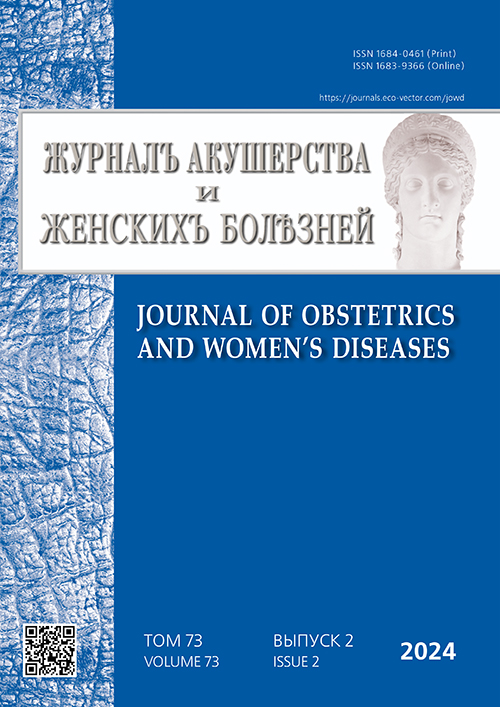Possibilities of using lactobacilli metabolites for the treatment and prevention of bacterial vaginosis
- 作者: Minakova A.D.1, Dzhibladze T.A.1, Zuev V.M.1
-
隶属关系:
- I.M. Sechenov First Moscow State Medical University (Sechenov University)
- 期: 卷 73, 编号 2 (2024)
- 页面: 149-154
- 栏目: Clinical practice guidelines
- ##submission.dateSubmitted##: 04.02.2024
- ##submission.dateAccepted##: 29.02.2024
- ##submission.datePublished##: 27.05.2024
- URL: https://journals.eco-vector.com/jowd/article/view/626455
- DOI: https://doi.org/10.17816/JOWD626455
- ID: 626455
如何引用文章
详细
Bacterial vaginosis is one of the most common reasons for pathological discharge from the genital tract in women of reproductive age, which, among other things, is characterized by a high recurrence rate after standard antibacterial treatment. To date, issues related to the prevention and treatment of bacterial vaginosis have remained relevant and unresolved. This review article discusses the feasibility of using lactobacilli metabolites in the treatment and prevention of bacterial vaginosis, taking into account the data accumulated. The use of lactic acid as an additional second stage of bacterial vaginosis treatment can be considered as a way to improve the effectiveness of therapy and patient adherence to treatment, as well as to reduce the likelihood of recurrences.
全文:
作者简介
Alena Minakova
I.M. Sechenov First Moscow State Medical University (Sechenov University)
Email: alenami1205@yandex.ru
ORCID iD: 0000-0002-5157-1888
SPIN 代码: 6649-7776
MD, postgraduate student
俄罗斯联邦, 8-2 Trubetskaya St., Moscow, 119048Tea Dzhibladze
I.M. Sechenov First Moscow State Medical University (Sechenov University)
Email: djiba@bk.ru
ORCID iD: 0000-0003-1540-5628
SPIN 代码: 5688-1084
Scopus 作者 ID: 57194218506
MD, Dr. Sci. (Med.), Professor
俄罗斯联邦, 8-2 Trubetskaya St., Moscow, 119048Vladimir Zuev
I.M. Sechenov First Moscow State Medical University (Sechenov University)
编辑信件的主要联系方式.
Email: vlzuev@bk.ru
ORCID iD: 0000-0001-8715-2020
SPIN 代码: 2857-0309
Scopus 作者 ID: 7201884764
MD, Dr. Sci. (Med.), Professor
俄罗斯联邦, 8-2 Trubetskaya St., Moscow, 119048参考
- Kenyon CR, Buyze J, Klebanoff M, et al. Association between bacterial vaginosis and partner concurrency: a longitudinal study. Sex Transm Infect. 2018;94(1):75–77. doi: 10.1136/sextrans-2016-052652
- Brotman RM, Klebanoff MA, Nansel TR, et al. A longitudinal study of vaginal douching and bacterial vaginosis – a marginal structural modeling analysis. Am J Epidemiol. 2008;168(2):188–196. doi: 10.1093/aje/kwn103
- Madden T, Grentzer JM, Secura GM, et al. Risk of bacterial vaginosis in users of the intrauterine device: a longitudinal study. Sex Transm Dis. 2012;39(3):217–222. doi: 10.1097/OLQ.0b013e31823e68fe
- Brotman RM, He X, Gajer P, et al. Association between cigarette smoking and the vaginal microbiota: a pilot study. BMC Infect Dis. 2014;14:471. doi: 10.1186/1471-2334-14-471
- Boskey ER, Cone RA, Whaley KJ, et al. Origins of vaginal acidity: high D/L lactate ratio is consistent with bacteria being the primary source. Hum Reprod. 2001;16(9):1809–1813. doi: 10.1093/humrep/16.9.1809
- Amabebe E, Anumba DOC. The vaginal microenvironment: the physiologic role of Lactobacilli. Front Med. 2018;5:181. doi: 10.3389/fmed.2018.00181
- Tyssen D, Wang YY, Hayward JA, et al. Anti-HIV-1 activity of lactic acid in human cervicovaginal fluid. mSphere. 2018;3(4). doi: 10.1128/mSphere.00055-18
- Conti C, Malacrino C, Mastromarino P. Inhibition of herpes simplex virus type 2 by vaginal lactobacilli. J Physiol Pharmacol. 2009;60(Suppl 6):19–26.
- Gong Z, Luna Y, Yu P, et al. Lactobacilli inactivate Chlamydia trachomatis through lactic acid but not H2O2. PLoS One. 2014;9(9). doi: 10.1371/journal.pone.0107758
- Foschi C, Salvo M, Cevenini R, et al. Vaginal lactobacilli reduce neisseria gonorrhoeae viability through multiple strategies: an in vitro study. Front Cell Infect Microbiol. 2017;7:502. doi: 10.3389/fcimb.2017.00502
- Hearps AC, Tyssen D, Srbinovski D, et al. Vaginal lactic acid elicits an anti-inflammatory response from human cervicovaginal epithelial cells and inhibits production of pro-inflammatory mediators associated with HIV acquisition. Mucosal Immunol. 2017;10(6):1480–1490. doi: 10.1038/mi.2017.27
- O’Hanlon DE, Moench TR, Cone RA. In vaginal fluid, bacteria associated with bacterial vaginosis can be suppressed with lactic acid but not hydrogen peroxide. BMC Infect Dis. 2011;11:200. doi: 10.1186/1471-2334-11-200
- Miko E, Barakonyi A. The role of hydrogen-peroxide (H2O2) produced by vaginal microbiota in female reproductive health. Antioxidants. 2023;12(5):1055. doi: 10.3390/antiox12051055
- Chaithongwongwatthana S, Limpongsanurak S, Sitthi-Amorn C. Single hydrogen peroxide vaginal douching versus single-dose oral metronidazole for the treatment of bacterial vaginosis: a randomized controlled trial. J Med Assoc Thai. 2003;86( Suppl 2):S379–S384.
- Ross JDC, Brittain C, Anstey Watkins J, et al. Intravaginal lactic acid gel versus oral metronidazole for treating women with recurrent bacterial vaginosis: the VITA randomised controlled trial. BMC Womens Health. 2023;23(1):241. doi: 10.1186/s12905-023-02303-5
- Mendling W, Shazly MAE, Zhang L. The Role of lactic acid in the management of bacterial vaginosis: a systematic literature review. Future Pharmacology. 2022;2(3):198–213. doi: 10.3390/futurepharmacol2030014
补充文件





